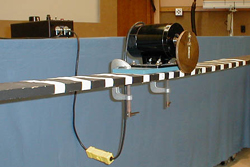Demos: 1S-23 Reaction Force in Resonance

An eccentric wheel is attached to the shaft of an electric motor which, in turn in attached to the center of a long wooden plank whose ends are supported by two stools. When the shaft rotates at the resonant frequency of the plank, the plank is set into strong vibrations.
Directions: The motor speed is controlled by a rheostat. The resonant frequency of the board is of the order of 2 Hz, so the motor must be brought up to speed very slowly. The system is very sensitive to the rotation speed and at this low speed, the motor is on the verge of stalling. Patience and attention to the response of the system will insure that it works. One way to approach this is to set the motor speed higher and then back off, coming to the resonance point from the high side.
Suggestions for Presentation: Ask if anyone knows what causes an unbalanced tire to vibrate. Does it vibrate at all speeds, or does it tend to happen at a particular speed? If you have done the interference pendula demos (1S - 20, 1S - 40), point out that in coupled systems energy is transferred from one part to the other quite efficiently at resonance. The suspension system of a car has a resonance frequency such that when the tire is rotating at that speed, the vibrations of the unbalanced tire are transmitted efficiently to the suspension system.
Applications: The balancing of tires, the careful balancing of fan blades in a jet engine, etc.
Last Updated: Nov 30, 2023 11:25 AM